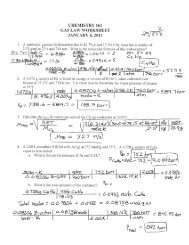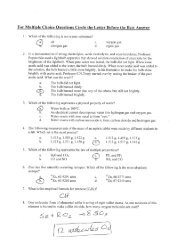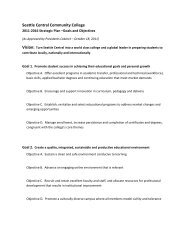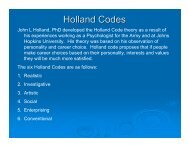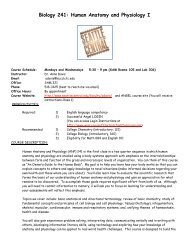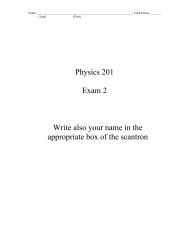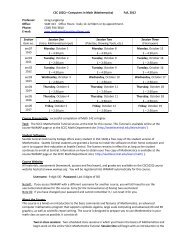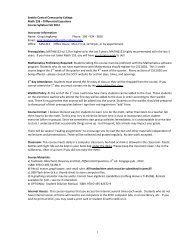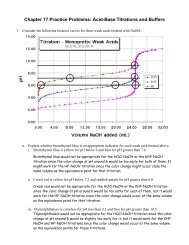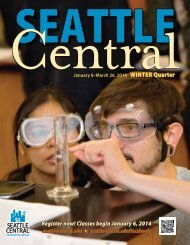Eco200: Practice Test 1 Covering Chapters 10 through 15
Eco200: Practice Test 1 Covering Chapters 10 through 15
Eco200: Practice Test 1 Covering Chapters 10 through 15
- No tags were found...
You also want an ePaper? Increase the reach of your titles
YUMPU automatically turns print PDFs into web optimized ePapers that Google loves.
Name __________________<strong>Eco200</strong>: <strong>Practice</strong> <strong>Test</strong> 1<strong>Covering</strong> <strong>Chapters</strong> <strong>10</strong> <strong>through</strong> <strong>15</strong>1. Many observers believe that the levels of pollution in our society are too high.a. If society wishes to reduce overall pollution by a certain amount, why is it efficient to havedifferent amounts of reduction at different firms?b. Command-and-control approaches often rely on uniform reductions among firms. Why are theseapproaches generally unable to target the firms that should undertake bigger reductions?c. Economists argue that appropriate corrective taxes or tradable pollution rights will result inefficient pollution reduction. How do these approaches target the firms that should undertakebigger reductions?Solution: A Chapter <strong>10</strong> problem, externalities…a. It is efficient to have different amounts of pollution reduction at different firms because the costs ofreducing pollution differ across firms. If they were all made to reduce pollution by the same amount, thecosts would be low at some firms and prohibitive at others, imposing a greater burden overall.b. Command-and-control approaches that rely on uniform pollution reduction among firms give the firmsno incentive to reduce pollution beyond the mandated amount. Instead, every firm will reduce pollution byjust the amount required and no more.c. Corrective taxes or tradable pollution rights give firms greater incentives to reduce pollution.Firms are rewarded by paying lower taxes or spending less on permits if they find methods to reducepollution, so they have the incentive to engage in research on pollution control. The government does nothave to figure out which firms can reduce pollution the most it lets the market give firms the incentive toreduce pollution on their own.
3. Federal and State Expenditures:a. Social Security payments have increased dramatically. Explain why this is a problem and what iscausing the increase?b. What is the single-most largest expenditure for state governments?c. What is the single-most largest expenditure for the federal government?Solution: Chapter 12, Social Security…a. Increasing in life expectancy, “Baby Boom” generation retiring, health care costs have risen morerapidly than the cost of other goods and services produced in the economy…b. State governments usually possess the largest expenditures in Education…c. This is somewhat of a trick question because the federal government spends about the same forNational Defense and Social Security Payments, 456 billion (in 2004) on National Defense and496 (in 2004) on Social Security Payments. Many people believe that National Defense is thelargest expenditure for the federal government, which is a common misperception.
4. Excessive fishing occurs because each individual fisherman has little incentive to maintain the speciesfor the following year.a. The fish in the ocean can be considered which type of good, private, public, common resources, ornatural monopoly. When describing which type of good, be sure to specify if fish are rival and/orexcludable.b. Why is there a problem with fish while there is no problem with cows?c. How can governments solve this problem?d. Give some reasons why this solution sometimes fails?Solution: Chapter 11 problem…a. Fish in the ocean are common resources, rival and not excludable. Fish are rival in that every timea fisherman catches one it prevents someone from catching that same fish. Fish are not excludablebecause you cannot prevent people from fishing unless the government takes action, sayrestrictions, corrective taxes, or tradable permits.b. Cows are private property while fish in the ocean are common resources, as long as there are nopermits sold for fish. If the government chooses to sell permits for the fish, then the fish become aprivate good.c. Tradable permits or corrective taxes will help alleviate the problem since the quantity of fishcaught depends on some form of fee <strong>through</strong> taxation or permits.d. Many countries have access to the ocean. It is difficult to get international cooperation amongcountries that hold different values. The oceans are so vast that enforcing any agreement would bedifficult.
5. Consider the following demand and cost information for a monopoly.Quantity Price TotalCost0 $30 $31 25 72 20 123 <strong>15</strong> 184 <strong>10</strong> 25a. What is the marginal revenue for the second unit?b. What is the marginal cost for the fourth unit?c. What is the maximum profit this monopolist can earn?d. What price does the monopolist set?Solution:a. $<strong>15</strong>b. $7c. $28d. $20Q P TR MR TC MC Profit(TR – TC)0 $30 0 - $3 - -31 25 25 25 7 4 182 20 40 <strong>15</strong> 12 5 283 <strong>15</strong> 45 5 18 6 174 <strong>10</strong> 40 5 25 7 <strong>15</strong>
6. Adrian's Premium Chocolates produces boxes of chocolates for its mail order catalogue business. Sherents a small room for $<strong>15</strong>0 a week in the downtown business district that serves as her factory. Shecan hire workers for $275 a week. There are no implicit costs.NumberofWorkersBoxes ofChocolatesProducedper WeekMarginalProductof LaborCost ofFactoryCost ofWorkersTotalCostofInputs0 01 330 <strong>15</strong>0 275 4252 6303 <strong>15</strong>0 825 9754 8905 950 60 13756 <strong>10</strong> 1800a. What is the marginal product of the second worker?b. What is the total cost associated with making 890 boxes of premium chocolates per week?c. During the week of July 4th, Adrian doesn't box any chocolates. What are her costs during theweek?d. Adrian has received an order for 3,000 boxes of chocolates for next week. If she expects that thetrend in the marginal product of labor will continue in the same direction, what should Adrian do?Solutions: Chapter 13 problem…a. 300. In order to figure this out, calculate the # of boxes of chocolates produced per Week at thelevel of one worker, which would be 330 boxes. Now, if you add a second worker, the # of boxesincreases from 330 to 630. The difference between 630 and 330 is 300, which is the marginalproduct of the second worker.b. $1,250. Looking at the row of 3 Numbers of workers. The total cost of workers is $825. Thus,add another worker at $275, which adds up to $1<strong>10</strong>0. The remaining is the fixed cost of thefactory or $<strong>15</strong>0. This gives a grand total of $1250c. $<strong>15</strong>0. Just the fixed cost of the factory…d. She should not commit to meeting the order until she can move to a larger room and hire moreworkers to box the chocolates.



